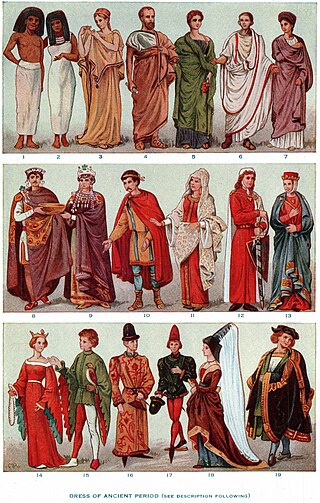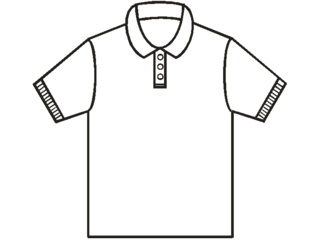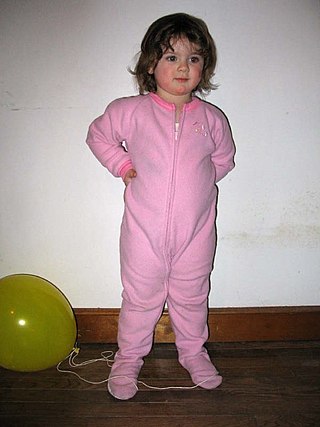
A wedding is a ceremony where two people are united in marriage. Wedding traditions and customs vary greatly between cultures, ethnic groups, races, religions, denominations, countries, social classes, and sexual orientations. Most wedding ceremonies involve an exchange of marriage vows by a couple, presentation of a gift, and a public proclamation of marriage by an authority figure or celebrant. Special wedding garments are often worn, and the ceremony is sometimes followed by a wedding reception. Music, poetry, prayers, or readings from religious texts or literature are also commonly incorporated into the ceremony, as well as superstitious customs.

Clothing is any item worn on the body. Typically, clothing is made of fabrics or textiles, but over time it has included garments made from animal skin and other thin sheets of materials and natural products found in the environment, put together. The wearing of clothing is mostly restricted to human beings and is a feature of all human societies. The amount and type of clothing worn depends on gender, body type, social factors, and geographic considerations. Garments cover the body, footwear covers the feet, gloves cover the hands, while hats and headgear cover the head, and underwear covers the private parts.

A parka and anorak is a type of coat with a hood, often lined with fur or faux fur. These two kinds of garments are staple of Inuit clothing, traditionally made from caribou or seal skin, for hunting and kayaking in the frigid Arctic. Some Inuit anoraks require regular coating with fish oil to retain their water resistance. Parkas are typically longer, often extending to the thighs or knees. Anoraks are usually shorter than parkas, often hip-length, and are traditionally a pull-over jacket.

A sweater or pullover, also called a jersey or jumper, is a piece of clothing, typically with long sleeves, made of knitted or crocheted material that covers the upper part of the body. When sleeveless, the garment is often called a slipover, tank top, or sweater vest.

A hood is a type of headgear or headwear that covers most of the head and neck, and sometimes the face. Hoods that cover mainly the sides and top of the head, and leave the face mostly or partly open may be worn for protection from the environment, for fashion, as a form of traditional dress or uniform, or in the case of knights, an armoured hood is used for protection against bladed weapons. In some cases, hoods are used to prevent the wearer from seeing where they are going. Hoods with eye holes may be used for religious purposes to prevent the wearer from being seen. In the case of Ku Klux Klan members, terrorists, or criminals such as robbers, a hood with eye holes helps prevent identification.

A jacket is a garment for the upper body, usually extending below the hips. A jacket typically has sleeves and fastens in the front or slightly on the side. A jacket is generally lighter, tighter-fitting, and less insulating than a coat, which is outerwear. Some jackets are fashionable, while others serve as protective clothing. Jackets without sleeves are vests.

A polo shirt, tennis shirt, golf shirt, or chukker shirt is a form of shirt with a collar. Polo shirts are usually short sleeved but can be long; they were used by polo players originally in India in 1859 and in Great Britain during the 1920s.

Áo dài is a modernized Vietnamese national garment consisting of a long split tunic worn over silk trousers. It can serve as formalwear for both men and women. Áo translates as shirt and dài means "long". The term can also be used to describe any clothing attire that consists of a long tunic, such as nhật bình.

The blanket sleeper is a type of especially warm sleeper or footie pajama worn primarily during the winter in the United States and Canada. The garment is worn especially by young children.
A cowl is an item of clothing consisting of a long, hooded garment with wide sleeves, often worn by monks.
Clothing terminology comprises the names of individual garments and classes of garments, as well as the specialized vocabularies of the trades that have designed, manufactured, marketed and sold clothing over hundreds of years.

Song Lam Nghe An Football Club, simply known as Song Lam Nghe An or SLNA, is a professional V.League 1 football club playing at the Vinh Stadium in the city of Vinh, Nghe An province, Vietnam. This is a club that has won many titles from the V.League 1, Vietnamese Cup, Vietnamese Super Cup as well as youth tournaments and is one of the clubs that contributes the most players to the Vietnam national football team. Up to now, Song Lam Nghe An has had a tradition of only using internal soldiers who are players from the club's own training facility. Almost all of these players are from Nghe An, the rest are from Ha Tinh, so this can be considered the most unique club in the country. They are the first and only team to have reached 1000 points in the V.League.

Vietnamese clothing is the traditional style of clothing worn in Vietnam by the Vietnamese people. The traditional style has both indigenous and foreign elements due to the diverse cultural exchanges during the history of Vietnam. This all eventually led to the birth of a distinctive Vietnamese style of clothing, including the birth of the unofficial national dress of Vietnam, the áo dài.

Becamex Binh Duong Football Club, simply known as Becamex Binh Duong, is a professional football club based in Thủ Dầu Một, Bình Dương province, Vietnam. It currently plays in Vietnam's top division, the V.League 1. Their home ground is Gò Đậu Stadium.

Clothing fetishism or garment fetishism is a sexual fetish that revolves around a fixation upon a particular article or type of clothing, a particular fashion or uniform, or a person dressed in such a style.

A Baja jacket is a type of Mexican jacket with a single large pocket on the front, and vents on the side. They are more commonly made out of a coarse woolen fabric known as "jerga". They are often decorated with patterns consisting of horizontal stripes on the sleeves and hood, and vertical stripes down the rest of the jacket. The drawstrings are often flatter and more rectangular than most jacket drawstrings, and always made of the same material as the rest of the jacket.

Nguyễn Quang Hải is a former Vietnamese footballer. He was a member of the Vietnam national football team.

A cape is a clothing accessory or a sleeveless outer garment which drapes the wearer's back, arms, and chest, and connects at the neck.

Athleisure is a hybrid style of athletic clothing typically worn as everyday wear. The word is both a neo-logism and portmanteau combining the words 'athletic' and 'leisure'. Athleisure outfits can include tracksuits, sports jackets, hoodies, yoga pants, tights, sneakers, leggings and shorts that look like athletic wear, characterized as "fashionable, dressed-up sweats and exercise clothing". Since the 2010s, the pervasiveness of the athleisure phenomenon has experienced a significant surge in popularity, particularly within the everyday life and daily routines of mainstream North Americans. This trend entails individuals opting to incorporate athletic clothing into their everyday attire, irrespective of their actual engagement in physical activities or not.

The áo giao lĩnh, also known as the giao lãnh y. Folk often call it áo tràng vạt or áo tràng xiên, referred to as áo tràng, was a traditional cross-collared robe worn by Vietnamese before the 19th century. It was a version of a type of historical Han Chinese clothing and was typically worn by the royalty, the aristocracy, the nobility, and the commoners. During the Nguyễn dynasty, it was replaced by the áo ngũ thân and became obsolete.























